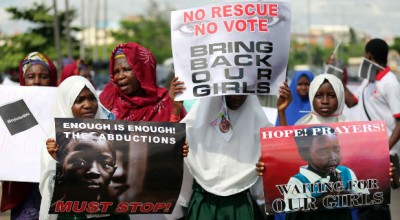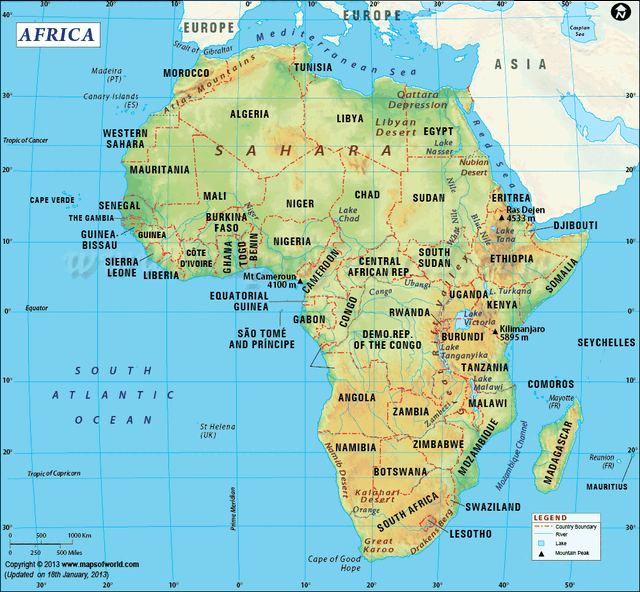Nigeria: Boko Haram Kidnappings Used to Justify US Military Build-Up in Africa

The United States has sent military and security “advisers” to Nigeria to help President Goodluck Jonathan’s government rescue more than 200 schoolgirls kidnapped by the Islamist group Boko Haram.
Britain has also sent security forces, with the former colonial power stating Thursday that it will be working closely with Washington.
On Friday, US secretary of state John Kerry said: “Our inter-agency team is hitting the ground in Nigeria now and they are going to be working in concert with President Goodluck Jonathan’s government to do everything that we possibly can to return these girls to their families and their communities.”
The kidnapping presents Washington, whose requests to mount military and intelligence operations from Nigeria had repeatedly been rebuffed, with a golden opportunity to secure a foothold in the oil-rich country, now Africa’s largest economy. This is part of its efforts to build up a string of military bases across the Horn of Africa, the Sahel and West Africa.
The move is in line with a broader “pivot to Africa,” aimed at securing control of the continent’s huge mineral and energy resources and containing, if not excluding, China from Africa. China has now surpassed the US as Africa’s foremost trading partner and has huge mining, energy and infrastructure investments in the continent.
The US has used the “war on terror” to justify its interventions in North Africa, the Sahel and now the West African state of Nigeria. But the reality is that the US-NATO war for regime change in Libya—carried out at least in part because Libyan leader Muammar Gaddafi had for decades blocked Washington’s efforts to dominate Africa—served to destabilise the entire region.
 The political divisions of Africa
The political divisions of AfricaIslamist forces, this time Boko Haram—the very forces that the US and NATO backed and armed in Libya as a proxy ground force in the war to topple Gaddafi—are being used as the bogey man to justify the intervention of US military forces.
The major European powers that once ruled large parts of Africa, but which no longer have the military resources to resume control of their former colonial possessions unaided, have welcomed the US military interventions in Africa, most recently in Libya, Mali, Niger and the Central African Republic, as a means of securing their own interests.
It was with American geostrategic interests in mind that in 2008 the Bush administration set up US Africa Command (AFRICOM). The Obama administration has expanded AFRICOM to around 5,000 personnel stationed in Africa, with a presence in 38 countries. The US now has more troops in Africa than at any time since its intervention in Somalia in 1993.
AFRICOM also has a civilian component to provide it with a development, good “governance” and “humanitarian” cover, able to influence the domestic and foreign policies of African states, under conditions where there is widespread opposition to the basing of US military forces. Since no African nation has been willing to host a full US base, AFRICOM is based in Stuttgart, Germany.
The scale of its activities is vast. AFRICOM commander General David Rodriguez said that last year the US military carried out 546 “activities” on the continent, up from 172 in 2008, making a total over the years of around 1,000 “activities”.
The TomDispatch.com web site gained access to a cache of previously undisclosed military briefing documents prepared for top commanders and civilian officials in 2013. It revealed that military operations were far more extensive than previously reported. The US army in Africa took part in about 80 percent of AFRICOM activities. Its activities with at least 49 of the 54 African nations (excluding Egypt) during 2012 and 2013 ranged from special ops raids to training proxy forces. Last year, US Special Forces carried out training exercises with the Sudan People’s Liberation Army in Nzara on the outskirts of Yambio in southwest South Sudan.
A similar level of activity is planned for 2014 that will include full-scale exercises with the armed forces of at least 20 African countries, and “counterterrorism” activities.
Only a few weeks ago, AFRICOM undertook a series of naval manoeuvres not far from the Nigerian port of Lagos, under the guise of strengthening the security of the states of West Africa. According to Deutsche Welle, “More than 30 warships from 20 countries are engaged in major manoeuvres along the West African cost. In addition to 11 West African nations, France, Germany, Portugal, Spain and the Netherlands as well as Denmark, Turkey, Brazil and the United States have dispatched ships, making the training manoeuvres one of Africa’s largest.” Of the non-African participants, Germany had the largest presence.
In February of this year, US special operations troops were training Tunisian troops in a remote base in Western Tunisia in counterterrorism tactics.
Washington claims that it has only a “light footprint” in Africa, with only one permanent AFRICOM base at Camp Lemonnier in Djibouti, the tiny state in the Horn of Africa, adjacent to Eritrea, Ethiopia and Somalia. This base is used for launching drone missile attacks and air strikes in Yemen, Somalia and East Africa, and is scheduled for a $750 million expansion.
But TomDispatch’s examination of official documents shows that the US in fact operates out of seven cooperative locations (CSLs) and a number of forward locations (FOLs) in Gabon, Kenya, Mali, Morocco, Tunisia, Namibia, Senegal, Uganda, Ethiopia and Zambia. It has reached an agreement with Sao Tome for a naval base there to safeguard US oil interests in the Gulf of Guinea.
The Joint Special Operations Task Force-Trans Sahara uses an airbase in Burkino Faso’s capital Ouagadougou for its “high-risk activities”, while an intelligence, surveillance and reconnaissance (ISR) unit operates out of Chad. The US military has 29 agreements to use international airports in Africa as refuelling centres.
In January 2013, President Barack Obama announced that he had secured an agreement with the Nigerien government to deploy 250 to 300 military personnel, including remote pilots and security and maintenance crews, in Niger, in the first instance in the capital Niamey. There were reportedly “no constraints to military-to-military cooperation” within that agreement.
The US Air Force used Niamey to launch Predator drones over Mali as part of US military support for the French invasion that included airlifting French and allied African troops and refuelling French military aircraft that have bombed cities and towns controlled by Islamist insurgents and Tuareg separatists. As part of the Mali operation, US Special Forces were sent to Niger, Nigeria, Burkina Faso, Senegal, Togo and Ghana.
In the 15 months since the agreement was announced, US activity out of Niamey has vastly increased. The international airport is now routinely used to launch drones for the aerial surveillance of all the North African and Saharan countries and to carry out aerial strikes against its opponents. A US State Department official warned this was an “open-ended” campaign that could last years, and was only “the first phase”.
The US has plans to build a new compound in Niger and other bases for surveillance in Ethiopia and the Seychelles, amid indications that it has a previously unacknowledged compound near Gao in northern Mali. US forces groomed the military officer who overthrew Mali’s elected government in 2012.
In January, Washington acknowledged that it had sent a team of advisers to Somalia in December. This is the first time American troops have been stationed there since militia fighters in the capital Mogadishu shot down two helicopters and killed 18 US servicemen in the 1993 “Black Hawk Down” incident. The ostensible purpose is to “support” African Union troops fighting al-Shabab Islamists in Somalia.
The US also has a rapid reaction force of 550 Marines stationed at an air base in Moron, Spain. With six V-22 Ospreys, tilt-rotor aircraft that take off and land like helicopters, and two refuelling tankers, the Marines are able to fly thousands of miles to remote locations in Africa. Last month, the Spanish government approved an increase in the numbers of troops to 850, and the number of aircraft to 16.

